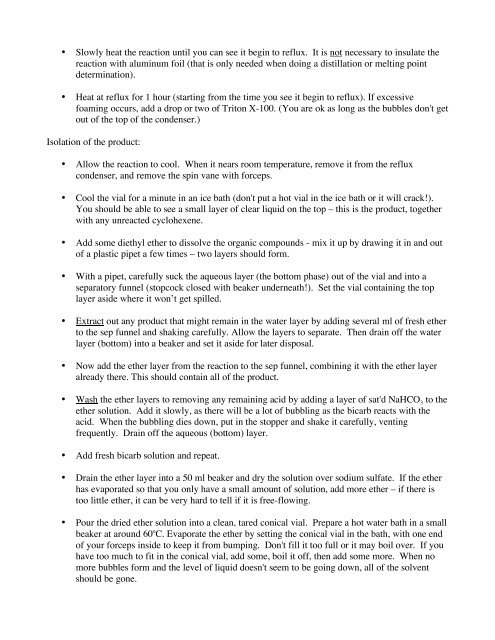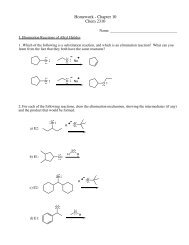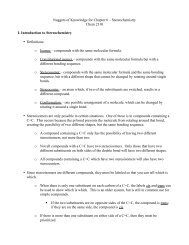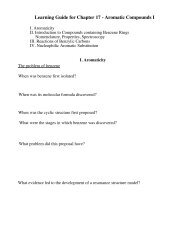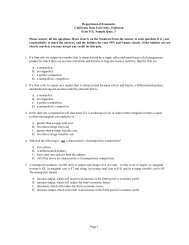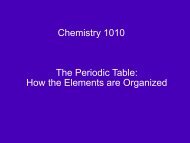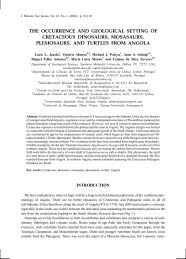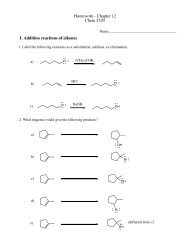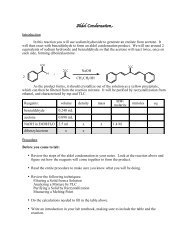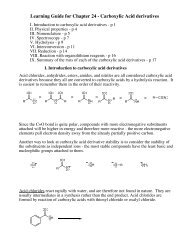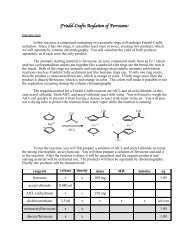Addition of HBr to Cyclohexene
Addition of HBr to Cyclohexene
Addition of HBr to Cyclohexene
- No tags were found...
Create successful ePaper yourself
Turn your PDF publications into a flip-book with our unique Google optimized e-Paper software.
• Slowly heat the reaction until you can see it begin <strong>to</strong> reflux. It is not necessary <strong>to</strong> insulate thereaction with aluminum foil (that is only needed when doing a distillation or melting pointdetermination).• Heat at reflux for 1 hour (starting from the time you see it begin <strong>to</strong> reflux). If excessivefoaming occurs, add a drop or two <strong>of</strong> Tri<strong>to</strong>n X-100. (You are ok as long as the bubbles don't ge<strong>to</strong>ut <strong>of</strong> the <strong>to</strong>p <strong>of</strong> the condenser.)Isolation <strong>of</strong> the product:• Allow the reaction <strong>to</strong> cool. When it nears room temperature, remove it from the refluxcondenser, and remove the spin vane with forceps.• Cool the vial for a minute in an ice bath (don't put a hot vial in the ice bath or it will crack!).You should be able <strong>to</strong> see a small layer <strong>of</strong> clear liquid on the <strong>to</strong>p – this is the product, <strong>to</strong>getherwith any unreacted cyclohexene.• Add some diethyl ether <strong>to</strong> dissolve the organic compounds - mix it up by drawing it in and out<strong>of</strong> a plastic pipet a few times – two layers should form.• With a pipet, carefully suck the aqueous layer (the bot<strong>to</strong>m phase) out <strong>of</strong> the vial and in<strong>to</strong> asepara<strong>to</strong>ry funnel (s<strong>to</strong>pcock closed with beaker underneath!). Set the vial containing the <strong>to</strong>player aside where it won’t get spilled.• Extract out any product that might remain in the water layer by adding several ml <strong>of</strong> fresh ether<strong>to</strong> the sep funnel and shaking carefully. Allow the layers <strong>to</strong> separate. Then drain <strong>of</strong>f the waterlayer (bot<strong>to</strong>m) in<strong>to</strong> a beaker and set it aside for later disposal.• Now add the ether layer from the reaction <strong>to</strong> the sep funnel, combining it with the ether layeralready there. This should contain all <strong>of</strong> the product.• Wash the ether layers <strong>to</strong> removing any remaining acid by adding a layer <strong>of</strong> sat'd NaHCO 3 <strong>to</strong> theether solution. Add it slowly, as there will be a lot <strong>of</strong> bubbling as the bicarb reacts with theacid. When the bubbling dies down, put in the s<strong>to</strong>pper and shake it carefully, ventingfrequently. Drain <strong>of</strong>f the aqueous (bot<strong>to</strong>m) layer.• Add fresh bicarb solution and repeat.• Drain the ether layer in<strong>to</strong> a 50 ml beaker and dry the solution over sodium sulfate. If the etherhas evaporated so that you only have a small amount <strong>of</strong> solution, add more ether – if there is<strong>to</strong>o little ether, it can be very hard <strong>to</strong> tell if it is free-flowing.• Pour the dried ether solution in<strong>to</strong> a clean, tared conical vial. Prepare a hot water bath in a smallbeaker at around 60 o C. Evaporate the ether by setting the conical vial in the bath, with one end<strong>of</strong> your forceps inside <strong>to</strong> keep it from bumping. Don't fill it <strong>to</strong>o full or it may boil over. If youhave <strong>to</strong>o much <strong>to</strong> fit in the conical vial, add some, boil it <strong>of</strong>f, then add some more. When nomore bubbles form and the level <strong>of</strong> liquid doesn't seem <strong>to</strong> be going down, all <strong>of</strong> the solventshould be gone.


